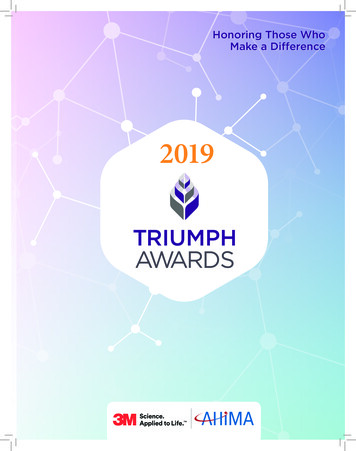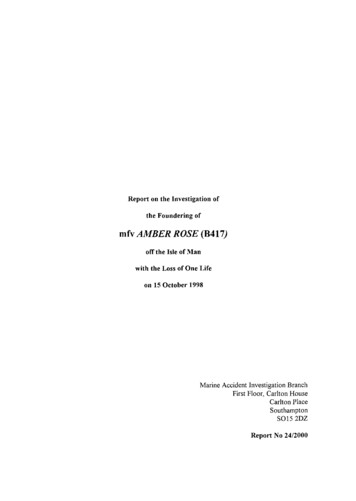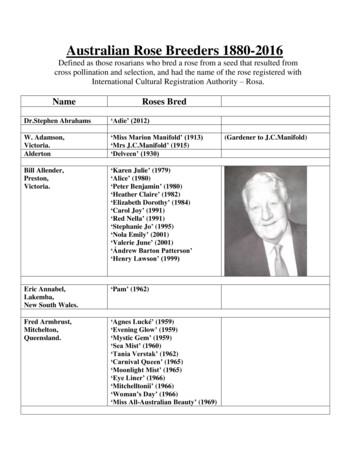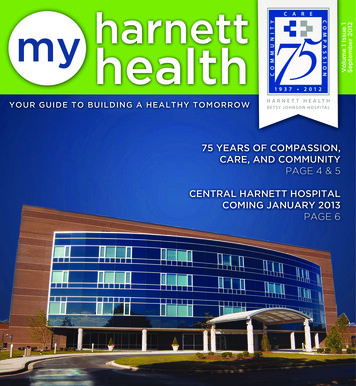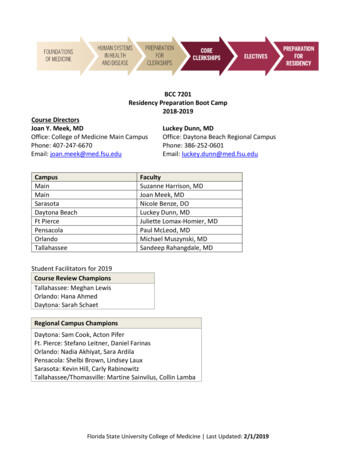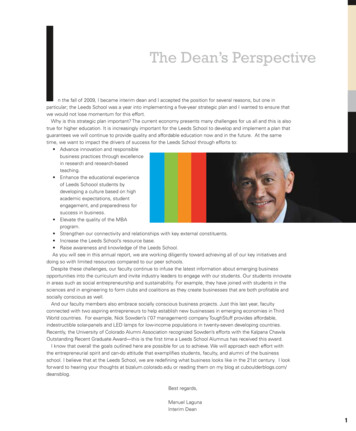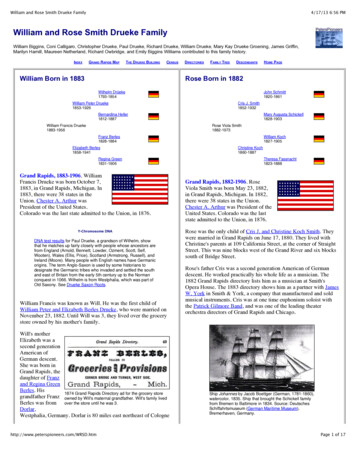
Transcription
SECOND EDITIONSECOND EDITIONThe Practical Guide toRELEASE OFI N F O R M AT I O NThe Practical Guide to Release of Information: ROI in a HITECH World provides anin-depth look at release of information from a legal, technological, and cost-effectivenessstandpoint. This definitive guide discusses regulations that affect ROI, how to design aneffective ROI department, the role of ROI in a legal environment, and technological applicationsfor ROI. It addresses practical management issues related to quality control, backlog,turnaround times, and productivity. It also provides relevant policies and procedures, jobdescriptions, tracking logs, and more.The Practical Guide toRELEASE OFI N F O R M AT I O NROI in a HITECH WorldR O S E T. D U N Nwith BEN BURTONFeatures include: Information on recent regulatory changes affecting ROI ROI specialist job descriptions, productivity expectations, cost analysis and copy charges,cross training, and other information needed to increase the efficiencyof your department Role of new technologies and efficiencies in ROI Easy-to-understand analysis of the role that ROI plays in subpoenas, depositions,and court appearances Strategies for safeguarding against lawsuits Breakdown of state regulations regarding ROIThe Practical Guide toR O S E T. D U N N , M B A , R H I A , C PA , C H P S , FA C H Ew i t h B E N B U R T O N , J D , M B A , R H I A , C H P, C H CR E L E A S E O F I N F O R M AT I O NROI in a HITECH WorldSECOND EDITIONHIMDG231221 MB327271 HIMDG2 Cover.indd 1a divisionof BLR100 Winners Circle, Suite 300Brentwood, TN 37027www.hcmarketplace.comR O S E T. D U N N , M B A , R H I A , C PA , C H P S , F A C H Ew i t h B E N B U R T O N , J D , M B A , R H I A , C H P, C H C11/17/15 11:34 AM
SECOND EDITIONThe Practical Guide toRELEASE OFINFORMATIONROI in a HITECH WorldROSE T. DUNN, MBA, RHIA, CPA, CHPS, FACHEWITH BEN BURTON, JD, MBA, RHIA, CHP, CHC
The Practical Guide to Release of Information: ROI in a HITECH World, Second Edition, is published by HCPro, a division of BLR.Copyright 2015 HCPro, a division of BLRAll rights reserved. Printed in the United States of America. 5 4 3 2 1ISBN: 978-1-55645-332-8No part of this publication may be reproduced, in any form or by any means, without prior written consent of HCPro or theCopyright Clearance Center (978-750-8400). Please notify us immediately if you have received an unauthorized copy.HCPro provides information resources for the healthcare industry.HCPro is not affiliated in any way with The Joint Commission, which owns the JCAHO and Joint Commission trademarks.Rose T. Dunn, MBA, RHIA, CPA, CHPS, FACHE, AuthorBen Burton, JD, MBA, RHIA, CHP, CHC, Co-authorAndrea Kraynak, CPC, EditorMelissa Osborn, Product DirectorErin Callahan, Vice President, Product Development & Content StrategyElizabeth Petersen, Executive Vice President, HealthcareMatt Sharpe, Production SupervisorVincent Skyers, Design Services DirectorVicki McMahan, Sr. Graphic DesignerMichael McCalip, Layout/Graphic DesignMichael King, Cover DesignerAdvice given is general. Readers should consult professional counsel for specific legal, ethical, or clinical questions.Arrangements can be made for quantity discounts. For more information, contact:HCPro100 Winners CircleSuite 300Brentwood, TN 37027Telephone: 800-650-6787 or 781-639-1872Fax: 800-785-9212 Email: customerservice@hcpro.comVisit HCPro online at www.hcpro.com and www.hcmarketplace.comiiThe Practical Guide to Release of Information 2015 HCPro
ContentsContentsAbout the Authors. vAcknowledgments. viiIntroduction. 1Chapter 1: What Is Release of Information?. 5Chapter 2: Release of Information: The Process.19Chapter 3: A Blueprint for Establishing Release of Information Services.61Chapter 4: Resources Necessary for Release of Information . 93Chapter 5: Why We Need to Know About Costs Associated WithRelease of Information. 109Chapter 6: Case Study: Bringing ROI In-House. 117Chapter 7: Release of Information Challenges. 125Chapter 8: Anatomy of the Copy Cost Lawsuit. 169Chapter 9: Patient Portals and ROI in Physician Practices. 183Chapter 10: E-Discovery. 193Chapter 11: Federal Preemption of State Release of Information Laws. 205Chapter 12: The HIPAA Omnibus Rule and the HITECH Act. 221Appendixes. 233 2015 HCProThe Practical Guide to Release of Informationiii
About the AuthorsAbout the AuthorsRose T. Dunn, MBA, RHIA, CPA, CHPS, FACHERose T. Dunn is a past president of the American Health Information Management Association(AHIMA) and recipient of AHIMA’s 1997 Distinguished Member Award. She is chief operating officer ofFirst Class Solutions, Inc., of St. Louis.Dunn began her career as director of medical records at Barnes Hospital, a 1,200-bed teaching hospitalin St. Louis that is now the flagship hospital of the BJC HealthCare system. Early in her career withBarnes, Dunn became vice president and was responsible for more than 1,600 employees and newbusiness development.After Barnes, Dunn joined Metropolitan Life Insurance Company, where she served as assistant vicepresident in MetLife’s HMO subsidiary. She also has served as chief financial officer of a dual hospitalsystem in Illinois.Her consulting firm, First Class Solutions, focuses primarily on HIM-related services, including codingsupport, coding audits, and operations improvement. Dunn also serves as an expert witness for releaseof information (ROI) lawsuits and advisor to organizations on ROI issues.Dunn is active in several professional associations, including the American Institute of Certified PublicAccountants, American College of Healthcare Executives (ACHE), Healthcare Finance ManagementAssociation (HFMA), and AHIMA. She also holds fellowship status in ACHE, AHIMA, and HFMA andis certified in healthcare privacy and security. 2015 HCProThe Practical Guide to Release of Informationv
About the AuthorsShe is the author of Finance Principles for the Health Information Manager, published by First ClassSolutions, Inc.; More With Less: Best Practices for HIM Directors and Coding Productivity, published byHCPro, Inc.; and Haimann’s Healthcare Management, published by Health Administration Press.Dunn also has published more than 200 articles and has made numerous presentations on a variety oftopics throughout the United States.Ben Burton, JD, MBA, RHIA, CHP, CHCBen Burton is a registered health information administrator (RHIA) and is certified in healthcareprivacy (CHP), both through AHIMA. He also is a certified healthcare compliance (CHC) professionalthrough the Healthcare Compliance Association.Burton holds a BS in HIM from St. Louis University, an MBA from the University Wisconsin–Milwaukee, and a JD with a health law certificate from St. Louis University School of Law. He hasbeen working in healthcare and health information privacy for more than 10 years. Currently, Burtonis an instructor in the Health Information Administration Program at Stephens College; a part-timeconsultant with First Class Solutions, Inc.; and the health information/compliance director withInterMed, P.A., a large multispecialty physician practice.He has presented on various healthcare compliance and privacy/security topics, as well as authored/coauthored several AHIMA practice briefs. Burton is currently a director of the Maine HealthInformation Management Association (MeHIMA) board of directors.viThe Practical Guide to Release of Information 2015 HCPro
AcknowledgmentsAcknowledgmentsNo book is ever the product of one person’s efforts, and this one is no exception. Many individualscontributed to its development, editing, formatting, and publication. I was fortunate to have some ofthe best working with me on this one.We were fortunate to engage my coauthor Benjamin Burton, JD, MBA, RHIA, CHP, CHC. Mr. Burtonupdated the work previously authored by Scott A. Edelstein, Esq., who, with support from DouglasA. Grimm wrote the chapters on two important topics: e-discovery and federal preemption of staterelease of information (ROI) laws. His associate, Douglas A. Grimm, Esq., provided research andwriting assistance for those chapters. Additionally, Mr. Burton contributed two new chapters for thisedition. Chapter 9 discusses patient portals and ROI activities in the physician practice setting. Thisnew chapter focuses on the unique issues that physician practices encounter with requests for patientinformation in both paper and electronic environments. Chapter 12 explores the impact of the HealthInsurance Portability and Accountability Act (HIPAA) Omnibus Rule, the HITECH Act, and the newand revised HIPAA rules including, but not limited to, business associate responsibilities, deceasedpatients' records, and new breach reporting requirements.Editor Andrea Kraynak thoroughly reviewed the manuscript, offered many valuable suggestions, andkept us on schedule to deliver this book prior to the end of 2015. Many of the downloadable formsand policies in this book came from practitioners who “live and breathe” ROI on a daily basis—DeniBronsing, privacy officer and health information management coordinator at the Bowen Center inWarsaw, Indiana, and Patricia Tooley, system executive for privacy compliance at Memorial HermannHealthcare System in Houston.MediCopy generously provided a way for our readers to easily obtain detailed information about copycost laws in all 50 states.Finally, the production staff, copyeditor and proofreader, graphic artists, and cover designer helpedkeep things running smoothly. They and many others behind the scenes made this book happen. Ithank the entire team for their assistance.Rose T. Dunn 2015 HCProThe Practical Guide to Release of Informationvii
IntroductionIntroductionRelease of information (ROI) has become the focal point of many health information management(HIM) departments and healthcare facilities. Patient interest in the content of their records, concernabout identity theft, and an increasingly transient patient population moving throughout the UnitedStates and to other countries make preparing and/or transmitting copies of medical records quickly anecessity.Demands on the ROI team and its function have grown tremendously with the added burden ofRecovery Audit Contractors, substance abuse legislation, the Health Insurance Portability andAccountability Act of 1996 (HIPAA), the Health Information Technology for Economic and ClinicalHealth (HITECH) Act of 2009, and e-discovery—the process by which litigants seek, locate, secure, andsearch electronic data for use as evidence.A task that was relatively simple in the past has evolved into a far more complex one requiringextensive knowledge of record content and applicable restrictions. It also requires the ability torespond to inquiries with accuracy and sensitivity about information the requestors may access—andinformation they may not be able to access.This book addresses these and other challenges. 2015 HCProThe Practical Guide to Release of Information1
IntroductionChapter 1 provides a foundation. It includes information about the federal laws that govern ROI and ahistorical overview demonstrating how the function has transitioned from a copy activity to one thatrequires knowledge of the regulations and the ability to decipher what may or may not be released.Chapter 2 discusses the ROI process in greater detail and offers guidance with respect to staffing thisfunction.Chapter 3 explains the necessary resources—policies and procedures, technology, and consumablesupplies—and complements the staffing information provided in Chapter 2.Chapter 4 explains and analyzes various methods of structuring the ROI function.Chapter 5 explores how to determine the costs of the ROI service.Chapter 6 offers a case study that examines an organization contemplating the internalization ofROI activities and provides guidance with respect to preparing a business plan for submission toadministration.Chapter 7 includes a detailed discussion of varied and challenging situations that ROI staff membersface daily. It offers advice on responding appropriately and with sensitivity.Chapter 8 provides insight with respect to copy charges and the litigation they inspire.Chapter 9 explores the use of patient portals and the unique requirements of release of information in aphysician practice.Chapter 10 provides detailed information about a relatively new concept in civil litigation, e-discovery.Chapter 11 discusses federal preemption of state ROI laws and uses specific examples to explain how todetermine which law prevails when state and federal law conflict.Chapter 12 summarizes the significant points of the HIPAA Omnibus Rule and the HITECH Act and theimpact on ROI and disclosure activities.The Appendixes include the results of a Medical Records Briefing 2014 ROI benchmarking surveypublished in January 2015 as well as a valuable state-by-state guide of medical record copying fees anda table of resources required for ROI.This book is for HIM department directors and managers in any healthcare setting and office managersin small physician practices. Our goal is to provide sources and guidance for these administrativeindividuals who direct and oversee the day-to-day activities of ROI.2The Practical Guide to Release of Information 2015 HCPro
IntroductionAs always, I welcome your comments and suggestions so that we can make the third edition evenbetter.Rose T. Dunn, MBA, RHIA, CPA, CHPS, FACHEChief Operating OfficerFirst Class Solutions, Inc.St. Louis, MissouriRose.Dunn@FirstClassSolutions.com 2015 HCProThe Practical Guide to Release of Information3
Chapter 1What Is Release of Information?Release of information (ROI) is the process of providing access to protected health information (PHI)to an individual or entity authorized to receive or review it. PHI is a term derived from a federal law,the Health Insurance Portability and Accountability Act of 1996 (HIPAA), that refers to health information about a specific patient. Authorization to release this information typically is provided bythe patient to whom it pertains or that patient’s legal representative. However, the staff working in ahealthcare organization’s ROI area may be responsible for monitoring and controlling access to PHIby others within the organization as well as by those who have a right to access PHI without patientauthorization.The ROI function previously was known as the correspondence or copy desk because staff membersreceived letters requesting copies of patient records. However, today, patients and other authorizedindividuals obtain copies of medical information in a variety of ways, including directly through apatient portal, electronically stored on a USB drive, and electronically written to a DVD.Fifty years ago, what has come to be known as the health information management (HIM) departmentwas called the medical records department, and the only mail it received was requests from insurers,attorneys, patients, and physicians for copies of medical records or professional journals and books.Fax machines were a rarity in both the medical records department and administration in those days.Today, the HIM department still receives conventional mail that includes requests for patient information along with glossy advertisements and the occasional professional journal that hasn’t convertedto an online format. But today’s requests for information also come via fax, email, and for some organizations, through a secured portal for information other than what the patient can access directly on 2015 HCProThe Practical Guide to Release of Information5
Chapter 1the organization’s health information portal. The requestors now include an array of third-party payers,researchers, quality improvement organizations, governmental and other external auditors, and, ofcourse, attorneys, patients, and physicians.More than 50 years ago, requests for copies of patient records were sent directly to physicians, whocopied and sent their records or instructed the medical record librarian to copy designated documentsand mail the copies to requesting parties. In those days, a written authorization might or might nothave existed. Today, if physicians are participating in the same health information exchange (HIE), noinformation needs to be “sent”; rather, physicians access the HIE, search for the patient who has beenreferred to them or whom they referred, and access the clinical findings—all through secure computeraccess. Times definitely have changed.With the advent of patient portals and HIEs, one would think the volume of requests being placed withthe HIM department would be diminishing. They are not. In fact, additional requestors are surfacing.For example, in one state, hospitals are responsible for validating that individuals who register for agun have not had behavioral health treatment. With the recent GermanWings crash1 and a study onphysician addiction,2 there likely will be additional policies related to reporting patient care documentation to various governmental authorities. Today, ROI occurs in a variety of settings—hospital HIM,radiology, human resources departments, home health agencies, physician offices, payers, specialtyscreening centers, urgent care, and skilled nursing facilities, to name just a few. Health information–credentialed staff members manage the function in some, but not all, of these venues.This decentralization of ROI has both advantages and disadvantages. One advantage is that manydepartments share the work, so it might not be necessary to add employees strictly for ROI. Anotheradvantage is that each department becomes “expert” with respect to the components of its records andcan address the contents of its records to comply with a request.However, the disadvantages are several:6 If a request for copies of patient records asks for “any and all documents” pertaining tothe patient, then first the request must be validated for reasonable purpose for “any andall documents.” If confirmed, then someone must copy the request and distribute it to alldepartments that may have records on the patient or one department must serve as theclearinghouse that gathers the records necessary to respond to the request. Organizations usingone or more electronic health records (EHR) are finding it easier to centralize the ROI becausea single department may be given the access rights to electronic documentation generated bymany staff members residing in many departments and available on several EHRs. When ROI remains decentralized, staff in each department/location must be fully educatedwith respect to federal and state laws and regulations that apply to ROI and to any ROI policiesimplemented by the facility. Maintaining a thorough and current understanding of regulationsand their nuances can be challenging, but this ensures that all departments involved in ROIremain up to date and have the technology available to provide requestors the necessaryThe Practical Guide to Release of Information 2015 HCPro
What Is Release of Information?information in the necessary format. Later chapters address an aspect of HIPAA known as “accounting of disclosures.” This processresults in a list of all disclosures of PHI to third parties that were not specifically authorizedby the patient. Collecting this information can be difficult when multiple departments orindividuals throughout the organization disclose information. It is further complicated by theuse of HIEs.These are just some of the reasons why centralizing ROI may be beneficial. Later chapters discuss othereffects of centralization and how to address them when necessary.New Formats for a New AgeHistorically, releasing PHI meant providing paper copies of various documents, and this practice stillcontinues today. For example, the HR department still might provide paper copies of health insuranceapplications and employment health testing results. Providers that have not transitioned completely toan EHR may have portions of their records in paper form. If requested, these portions of the record willneed to be copied or scanned.But today, releasing PHI doesn’t always involve paper copies of a patient’s records. For example, theconstant chase to have films returned and the high cost of preparing duplicate films encouragedradiology departments to implement electronic radiology imaging systems. Many radiology departments have started using picture archiving and communication systems (PACS) to eliminate the needto create radiologic films and the inherent storage requirements associated with them. PACS-equippedradiology departments often provide CDs containing requested images. Requestors are finding thatasking for paper copies only means that they will now need to store the paper. So now they arerequesting the copies be written to CDs, DVDs, or similar media that can easily be copied to theirdocument repositories and eliminate the bulk of paper.Release of PHI isn’t limited to paper copies and high-density media. A variety of other media environments serve this function, as well. For example, the cardiology imaging department might create andrelease copies of videos, and the pathology department might release slides containing treated slices ofspecimen. Some PHI is contained in tracing and monitoring systems such as fetal monitors, pulmonarymonitoring devices, anesthesia systems, and cardiology tests.With the intense focus on patient privacy and patients’ access to their health information, managingROI has never been more challenging than it is today. 2015 HCProThe Practical Guide to Release of Information7
Chapter 1Who Requests Access to Health Information?Health information demands are numerous. The variety of requestors includes but is not limited to: Other caregivers who serve the patient in the same or alternate settings Payers Payer agents who audit charges against documentation, review claims for excess paymentrecovery, or assess the necessity of services Governmental agencies such as the U.S. Department of Health and Human Services, theOccupational Safety and Health Administration, the U.S. Food and Drug Administration, qualityimprovement organizations, state departments of health, and others that use the information tofurther their purposes Researchers who collect data to obtain more information about established disease conditionssuch as cancer or to treat conditions more effectively Operational teams that gauge the performance of healthcare providers and organizations byidentifying pathways to provide more efficient care Insurers that want to evaluate the health of applicants Attorneys who want to determine the extent of injuries Patients who want to monitor their health or take information to a specialist or other physician Family members who need the information to obtain additional care or reimbursement for thecare provided to a relativeThroughout this book we will be discussing disclosure of patient information. Often this term isconfused with use of patient information. Briefly, disclosure means releasing patient informationoutside of the organization, while use means using the patient’s data within the organization generallyfor patient treatment, payment, or healthcare operational activities. Figure 1.1 presents a sample policyon the uses of PHI for treatment, payment, and healthcare operations.8The Practical Guide to Release of Information 2015 HCPro
What Is Release of Information?Figure 1.1 Uses and Disclosures of PHI for Treatment, Payment, andHealthcare OperationsTitle: Uses and Disclosures of PHI for Treatment, Payment, and Healthcare OperationsPolicy: PHI for which this organization is responsible may be used and disclosed for treatment, payment, andhealthcare operations (TPO) only in accordance with HIPAA and other laws and regulations, and with our privacynotice.Purpose: To protect patient privacy and ensure regulatory compliance, this policy outlines the requirements thatmust be followed when using or disclosing PHI for purposes of TPO.Scope: This policy applies to PHI in any form that is being used or disclosed for the purposes of TPO. It applies toour workforce, affiliates, agents, and business associates.GENERAL RULES:1. Except where prohibited by state or federal laws, we may use and disclose PHI for treatment, payment, and ourown healthcare operations without permission from an individual who is the subject of the PHI.2. We may disclose PHI for the healthcare operations of another covered entity (CE) provided that the receiving CEhas or had a relationship with the patient who is the subject of the PHI, the PHI pertains to that relationship, andthe disclosure is for a purpose listed below: Conducting quality assessment and improvement activities, including outcomes evaluation and development of clinical guidelines, provided that the obtaining of generalizable knowledge is not the primary purpose of any studies resulting from such activities; population-based activities relating to improving healthor reducing healthcare costs; protocol development; case management and care coordination; contacting ofhealthcare providers and patients with information about treatment alternatives; and related functions thatdo not include treatment Reviewing the competence or qualifications of healthcare professionals; evaluating practitioner and provider performance; reviewing health plan performance; conducting training programs in which students,trainees, or practitioners in areas of healthcare learn under supervision to practice or improve their skills ashealthcare providers; training of nonhealthcare professionals; and accreditation, certification, licensing, orcredentialing activities For the purpose of healthcare fraud and abuse detection or compliance3. Uses and disclosures of PHI must be consistent with our privacy notice.4. The minimum necessary standard applies to uses and disclosures of PHI except for treatment purposes. 2015 HCProThe Practical Guide to Release of Information9
Chapter 1Figure 1.1 Uses and Disclosures of PHI for Treatment, Payment, andHealthcare Operations (cont.)5. State and/or federal laws define specially protected categories of information that require more stringent protection than afforded by HIPAA. A valid authorization form, signed by the individual or legal representative, isrequired prior to any disclosures of the following:a. HIV test resultsb. Alcohol and drug abuse records (42 CFR Part 2)c. Genetic screening test resultsd. Confidential communications of psychotherapy notes contained in medical records of treatment by a psychiatrist, social worker, psychologist (or graduate of or student enrolled in a doctoral degree program andworking under the supervision of a licensed psychologist), or licensed mental health nurse clinical specialiste. Other professional services of a licensed psychologistf. Social work counseling/therapyg. Domestic violence victims counselingh. Sexual assault counselingi. Psychotherapy notes documenting therapy sessions and kept by a mental health professional outside of apatient’s medical recordBecause this book discusses ROI throughout, distinguishing between patient consent and patientauthorization is also important and necessary. These terms often are used interchangeably, but thereis a distinction under HIPAA. Patient consent may be obtained but is not necessary to use the PHIfor treatment, payment, or healthcare operations. Patient authorization is necessary to disclose PHIto a third party for reasons other than treatment, payment, and healthcare operations. However, thisdistinction has become blurred with the development of HIEs where providers from inside and outsideof the source organization may access the information for patient care purposes.When an organization establishes an HIE, it often will incorporate language in its Notice of PrivacyPractices (NPP). The NPP also may include language to address the sharing of PHI among cliniciansfor treatment, the disclosure to payers, and the use of data for operational initiatives such as qualityreviews. However, when it comes to the NPP’s language for HIEs, often organizations will indicate that10The Practical Guide to Release of Information 2015 HCPro
What Is Release of Information?the organization participates in an HIE and then makes available a separate document for the patient to“opt out” of allowing their data to be included in the HIE data repository. (See Figure 1.2.)Figure 1.2 ABC Provider Health Information ExchangeABC Provider Health Information Exchange (HIE) Opt-OutName:Date of Birth://Street Address:City: State:Zip:Phone: Email:I hereby acknowledge and agree as follows:1. I WISH to OPT-OUT of the ABC Provider HIE
BEN BURTON, JD, MBA, RHIA, CHP, CHC. The Practical Guide to Release of Information: ROI in a HITECH World. provides an . . Healthcare System in Houston. MediCopy generously provided a way for our readers to easily obtain detailed information about copy . cost laws in all 50 states. Finally, the production staff, copyeditor and proofreader .
